View in other NatureServe Network Field Guides
NatureServe
Montana
Utah
Wyoming
Idaho
Wisconsin
British Columbia
South Carolina
Yukon
California
New York
Dainty Sulphur - Nathalis iole
General Description
[From Ferris and Brown 1981; Scott 1986; Opler and Wright 1999; Glassberg 2001; Pyle 2002] Forewing 1.3-1.5 cm. A tiny sulphur. Uppersurface black and yellow, forewing with broadly black forewing tips and black bar along inner margin; female with more extensive black; hindwing with some orange infused. Undersurface of forewing with orange or yellow basal patch and black submarginal spots, hindwing of summer form pale yellow, winter form olive-green.
Phenology
Many flights, March to December in the south where adults overwinter, becoming more common northward only in summer (Scott 1986). Early May to early December in Colorado (Brown 1957; Emmel 1964; Scott and Scott 1978), late June in northern California (Shapiro 1993), late July in Washington (Pyle 2002), early July to late September in Montana (FLMNH Lepidopterists' Society database).
Diagnostic Characteristics
Best determined by a combination of tiny size, yellow uppersurface with broad black forewing tips, undersurface of forewing with orange or yellow basal patch and black submarginal spots, hindwing olive-green.
Species Range
Montana Range
Range Descriptions
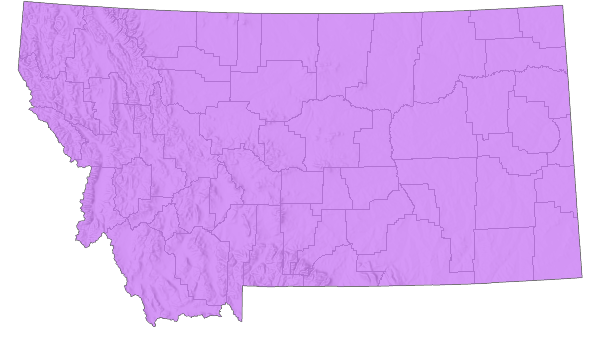
 Native
Native
Range Comments
Resident across the southern US from southern California to Florida, south through Mexico to Guatemala and the West Indies; vagrant and temporary breeding resident northward, with scattered records as far north as southeast Washington, Idaho, Montana, North Dakota, southern Manitoba and Ontario (Scott 1986; Opler and Wright 1999; Glassberg 2001; Guppy and Shepard 2001; Pyle 2002); 1311 m to 3962 m elevation but usually < 2743 m in Colorado (Brown 1957; Scott and Scott 1978), 2100 m to 2896 m elevation in the Sierra Nevada mountains in central and northern California (Clench 1976; Shapiro 1993). In Montana prior to 1993, reported from two counties, Missoula and Stillwater (Kohler 1980; Stanford and Opler 1993), but since reported east of the continental divide from an additional 12 counties east to the Dakotas (FLMNH Lepidopterists' Society database), from 605 m to 1603 m elevation. Uncommon to abundant, mainly common eastward and southward, decreasing immigrant northward (Glassberg 2001).
Observations in Montana Natural Heritage Program Database
Number of Observations: 1
(Click on the following maps and charts to see full sized version)
Map Help and Descriptions
Relative Density
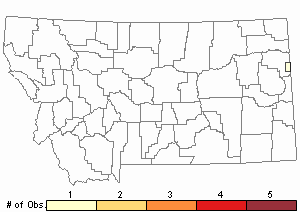
Recency
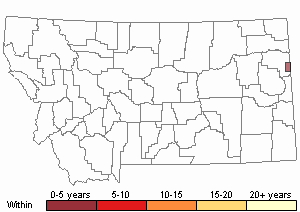
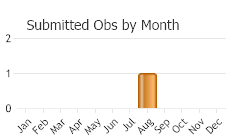
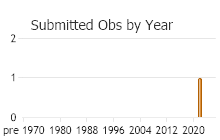 (Observations spanning multiple months or years are excluded from time charts)
(Observations spanning multiple months or years are excluded from time charts)
Migration
Migratory, although populations in the southeastern US (Florida, Georgia) are non-migratory; resident across southern US, moves long distances northward but does not return southward (Nabokov 1953; Clench 1976; Scott 1986; Shapiro 1993; Glassberg 2001; Pyle 2002).
Habitat
Dry meadows, desert, thorn scrub, weedy fields, prairies, road edges, hillsides, open woodland, parks and gardens, along irrigation ditches, abandoned agricultural fields, sometimes at high elevations (Emmel 1964; Ferris and Brown 1981; Scott 1986; Opler and Wright 1999; Glassberg 2001; Pyle 2002). Habitat in Montana not described but probably similar; most records from large river riparian corridors (FLMNH Lepidopterists' Society database).
Food Habits
Larval food plants include mostly native and exotic species of composites, such as Bahia, Bidens (multiple species), Cosmos, Dyssodia, Helenium, Hymenothrix, Palafoxia, Tagates, and Thelesperma, possibly non-composites such as Erodium, Galium, Mollugo, and Stellaria (Ferris and Brown 1981; Scott 1986, 1992, 2006; Graves and Shapiro 2003; James and Nunnallee 2011). Adults feed on flower nectar (including Achillea, Bidens, Cerastium, Chrysanthemum, Chrysothamnus, Coreopsis, Erigeron, Euphorbia, Geranium, Gutierrezia, Heterotheca, Heliopsis, Machaeranthera, Medicago, Oxalis, Pectis, Phyla, Sedum, Solidago, Symphyotrichum, Taraxacum, Tribulus, Trifolium, Verbena, Viola) and mud (Tooker et al. 2002; James and Nunnallee 2011; Scott 2014).
Reproductive Characteristics
Females lay eggs singly usually on the uppersurface of leaves of host plant seedlings, rarely on sepals (Scott 1986, 1992, 2006; James and Nunnallee 2011). Larvae develop from L1 to L4 instar and pupae in about 23 days, adults eclose (emerge from pupae) in another 15 days (about 38 days after egg-hatch), depending on temperature (James and Nunnalee 2011). Larvae build no nest, feed at night, cause "window-paning" of leaf when L1 instar, consume leaves and flower petals from edges as older instars, usually pupate horizontally on underside of leaf or vertically on stem of host plant; apparently no stage hibernates or undergoes diapause (Scott 1979, 1986; James and Nunnallee 2011). Males patrol throughout the day low to the ground in flats and other low areas in search of females (Scott 1975b, 1986; James and Nunnallee 2011).
Stewardship Responsibility
References
- Literature Cited AboveLegend:
 View Online Publication
View Online Publication Brown, F.M. 1957. Colorado Butterflies. Proceedings; Numbers Three through Seven. Denver Museum of Natural History, Denver, Co.
Brown, F.M. 1957. Colorado Butterflies. Proceedings; Numbers Three through Seven. Denver Museum of Natural History, Denver, Co. Clench, H.K. 1976. Nathalis iole (Pieridae) in the southeastern United States and the Bahamas. Journal of the Lepidopterists' Society 30:121-126.
Clench, H.K. 1976. Nathalis iole (Pieridae) in the southeastern United States and the Bahamas. Journal of the Lepidopterists' Society 30:121-126. Emmel, T.C. 1964. The ecology and distribution of butterflies in a montane community near Florissant, Colorado. American Midland Naturalist 72(2): 358-373.
Emmel, T.C. 1964. The ecology and distribution of butterflies in a montane community near Florissant, Colorado. American Midland Naturalist 72(2): 358-373. Ferris, C.D. and F.M. Brown (eds). 1981. Butterflies of the Rocky Mountains. Univ. of Oklahoma Press. Norman. 442 pp.
Ferris, C.D. and F.M. Brown (eds). 1981. Butterflies of the Rocky Mountains. Univ. of Oklahoma Press. Norman. 442 pp. Glassberg, J. 2001. Butterflies through Binoculars: A Field Guide to the Butterflies of Western North America. Oxford University Press.
Glassberg, J. 2001. Butterflies through Binoculars: A Field Guide to the Butterflies of Western North America. Oxford University Press. Graves, S.D. and A.M. Shapiro. 2003.Exotics as host plants of the California butterfly fauna. Biological Conservation 110: 413-433.
Graves, S.D. and A.M. Shapiro. 2003.Exotics as host plants of the California butterfly fauna. Biological Conservation 110: 413-433. Guppy, C.S. and J.H. Shepard. 2001. Butterflies of British Columbia: including western Alberta, southern Yukon, the Alaska Panhandle, Washington, northern Oregon, northern Idaho, northwestern Montana. UBC Press (Vancouver, BC) and Royal British Columbia Museum (Victoria, BC). 414 pp.
Guppy, C.S. and J.H. Shepard. 2001. Butterflies of British Columbia: including western Alberta, southern Yukon, the Alaska Panhandle, Washington, northern Oregon, northern Idaho, northwestern Montana. UBC Press (Vancouver, BC) and Royal British Columbia Museum (Victoria, BC). 414 pp. James, D.G. and D. Nunnallee. 2011. Life histories of Cascadia butterflies. Corvallis, OR: Oregon State University Press. 447 p.
James, D.G. and D. Nunnallee. 2011. Life histories of Cascadia butterflies. Corvallis, OR: Oregon State University Press. 447 p. Kohler, S. 1980. Checklist of Montana Butterflies (Rhopalocera). Journal of the Lepidopterists' Society 34(1): 1-19.
Kohler, S. 1980. Checklist of Montana Butterflies (Rhopalocera). Journal of the Lepidopterists' Society 34(1): 1-19. Nabokov, V. 1953. Butterfly collecting in Wyoming, 1952. The Lepidopterists' News 7(2): 49-52.
Nabokov, V. 1953. Butterfly collecting in Wyoming, 1952. The Lepidopterists' News 7(2): 49-52. Opler, P.A. and A.B. Wright. 1999. A field guide to western butterflies. Second edition. Peterson Field Guides. Houghton Mifflin Company, Boston, Massachusetts. 540 pp.
Opler, P.A. and A.B. Wright. 1999. A field guide to western butterflies. Second edition. Peterson Field Guides. Houghton Mifflin Company, Boston, Massachusetts. 540 pp. Pyle, R.M. 2002. The butterflies of Cascadia: a field guide to all the species of Washington, Oregon, and surrounding territories. Seattle Audubon Society, Seattle, Washington. 420 pp.
Pyle, R.M. 2002. The butterflies of Cascadia: a field guide to all the species of Washington, Oregon, and surrounding territories. Seattle Audubon Society, Seattle, Washington. 420 pp. Scott, J.A. 1975b. Mate-locating behavior of western North American butterflies. Journal of Research on the Lepidoptera 14:1-40.
Scott, J.A. 1975b. Mate-locating behavior of western North American butterflies. Journal of Research on the Lepidoptera 14:1-40. Scott, J.A. 1979. Hibernal diapause of North American Papilionoidea and Hesperioidea. Journal of Research on the Lepidoptera 18(3): 171-200.
Scott, J.A. 1979. Hibernal diapause of North American Papilionoidea and Hesperioidea. Journal of Research on the Lepidoptera 18(3): 171-200. Scott, J.A. 1986. The butterflies of North America: a natural history and field guide. Stanford University Press, Stanford, California.
Scott, J.A. 1986. The butterflies of North America: a natural history and field guide. Stanford University Press, Stanford, California. Scott, J.A. 1992. Hostplant records for butterflies and skippers (mostly from Colorado) 1959-1992, with new life histories and notes on oviposition, immatures, and ecology. Papilio new series #6. 185 p.
Scott, J.A. 1992. Hostplant records for butterflies and skippers (mostly from Colorado) 1959-1992, with new life histories and notes on oviposition, immatures, and ecology. Papilio new series #6. 185 p. Scott, J.A. 2006. Butterfly hostplant records, 1992-2005, with a treatise on the evolution of Erynnis, and a note on new terminology for mate-locating behavior. Papilio new series #14. 74 p.
Scott, J.A. 2006. Butterfly hostplant records, 1992-2005, with a treatise on the evolution of Erynnis, and a note on new terminology for mate-locating behavior. Papilio new series #14. 74 p. Scott, J.A. 2014. Lepidoptera of North America 13. Flower visitation by Colorado butterflies (40,615 records) with a review of the literature on pollination of Colorado plants and butterfly attraction (Lepidoptera: Hersperioidea and Papilionoidea). Contributions of the C.P. Gillette Museum of Arthopod Diversity. Fort Collins, CO: Colorado State University. 190 p.
Scott, J.A. 2014. Lepidoptera of North America 13. Flower visitation by Colorado butterflies (40,615 records) with a review of the literature on pollination of Colorado plants and butterfly attraction (Lepidoptera: Hersperioidea and Papilionoidea). Contributions of the C.P. Gillette Museum of Arthopod Diversity. Fort Collins, CO: Colorado State University. 190 p. Scott, J.A. and G.R. Scott. 1978. Ecology and distribution of the butterflies of southern central Colorado. Journal of Research on the Lepidoptera 17(2): 73-128.
Scott, J.A. and G.R. Scott. 1978. Ecology and distribution of the butterflies of southern central Colorado. Journal of Research on the Lepidoptera 17(2): 73-128. Shapiro, A.M. 1993. Long-range dispersal and faunal responsiveness to climatic change: a note on the importance of extralimital records. Journal of the Lepidopterists' Society 47:242-244.
Shapiro, A.M. 1993. Long-range dispersal and faunal responsiveness to climatic change: a note on the importance of extralimital records. Journal of the Lepidopterists' Society 47:242-244. Stanford, R.E. and P.A. Opler. 1993. Atlas of western USA butterflies: including adjacent parts of Canada and Mexico. Unpubl. Report. Denver and Fort Collins, Colorado 275 pp.
Stanford, R.E. and P.A. Opler. 1993. Atlas of western USA butterflies: including adjacent parts of Canada and Mexico. Unpubl. Report. Denver and Fort Collins, Colorado 275 pp. Tooker, J.F., P.F. Reagel, and L.M. Hanks. 2002. Nectar sources of day-flying lepidoptera of central Illinois. Annals of the Entomological Society of America 95(1): 84-96.
Tooker, J.F., P.F. Reagel, and L.M. Hanks. 2002. Nectar sources of day-flying lepidoptera of central Illinois. Annals of the Entomological Society of America 95(1): 84-96.
- Additional ReferencesLegend:
 View Online Publication
View Online Publication
Do you know of a citation we're missing? Allen, T.J., J.P. Brock, and J. Glassberg. 2005. Caterpillars in the field and garden: a field guide to the butterfly caterpillars of North America. Oxford University Press.
Allen, T.J., J.P. Brock, and J. Glassberg. 2005. Caterpillars in the field and garden: a field guide to the butterfly caterpillars of North America. Oxford University Press. Brock, J.P. and K. Kaufman. 2003. Kaufman Field Guide to Butterflies of North America. Houghton Mifflin Company, New York, NY 284 pp.
Brock, J.P. and K. Kaufman. 2003. Kaufman Field Guide to Butterflies of North America. Houghton Mifflin Company, New York, NY 284 pp. Forister, M.L., C.A. Halsch, C.C. Nice, J.A. Fordyce, T.E. Dilts, J.C. Oliver, K.L. Prudic, A.M. Shapiro, J.K. Wilson, J. Glassberg. 2021. Fewer butterflies seen by community scientists across the warming and drying landscapes of the American West. Science 371:1042-1045.
Forister, M.L., C.A. Halsch, C.C. Nice, J.A. Fordyce, T.E. Dilts, J.C. Oliver, K.L. Prudic, A.M. Shapiro, J.K. Wilson, J. Glassberg. 2021. Fewer butterflies seen by community scientists across the warming and drying landscapes of the American West. Science 371:1042-1045. Forister, M.L., E.M. Grames, C.A. Halsch, K.J. Burls, C.F. Carroll, K.L. Bell, J.P. Jahner, et al. 2023. Assessing risk for butterflies in the context of climate change, demographic uncertainty, and heterogeneous data sources. Ecological Monographs 93(3):e1584. https://doi.org/10.1002/ecm.1584
Forister, M.L., E.M. Grames, C.A. Halsch, K.J. Burls, C.F. Carroll, K.L. Bell, J.P. Jahner, et al. 2023. Assessing risk for butterflies in the context of climate change, demographic uncertainty, and heterogeneous data sources. Ecological Monographs 93(3):e1584. https://doi.org/10.1002/ecm.1584 Layberry, R.A., P.W. Hall, and J.D. LaFontaine. 1998. The Butterflies of Canada. University of Toronto Press. 280 pp. + color plates.
Layberry, R.A., P.W. Hall, and J.D. LaFontaine. 1998. The Butterflies of Canada. University of Toronto Press. 280 pp. + color plates.
- Web Search Engines for Articles on "Dainty Sulphur"
- Additional Sources of Information Related to "Insects"





